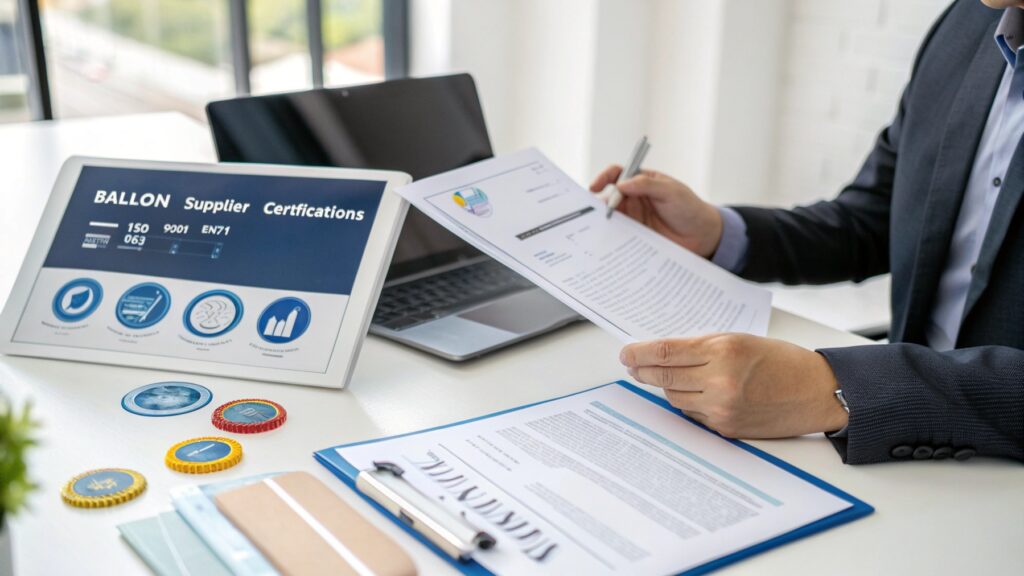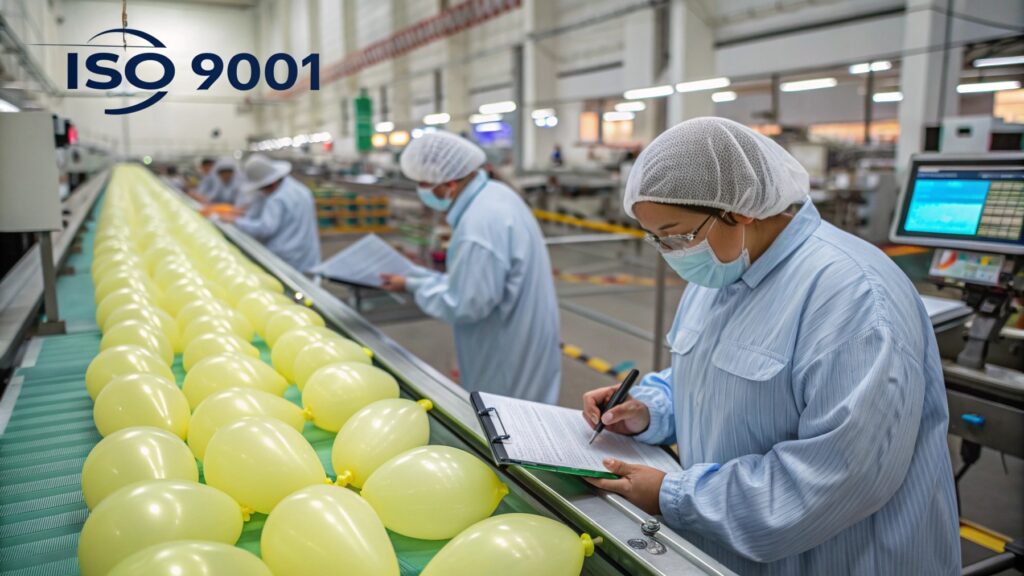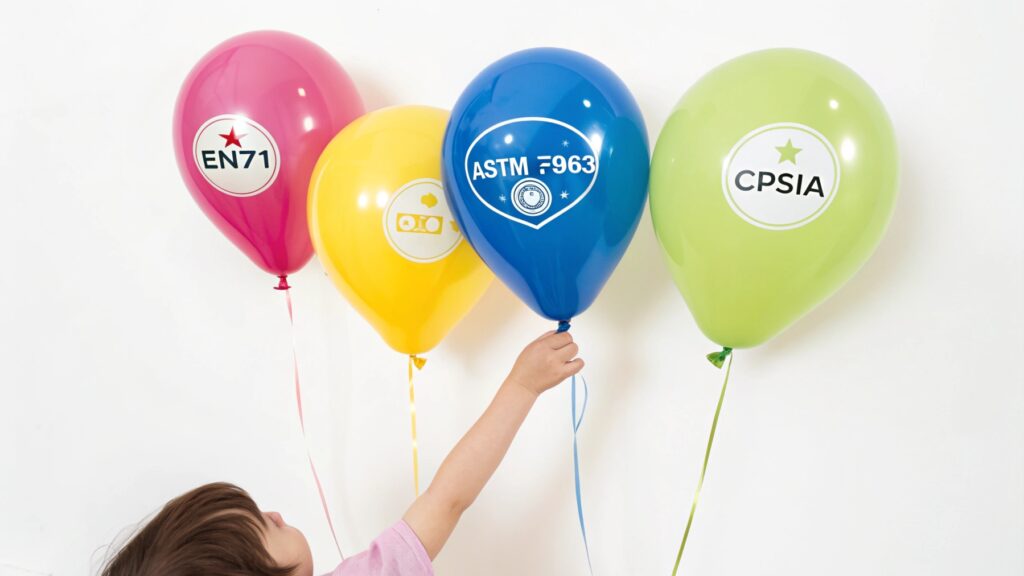What certifications should I look for in latex balloon suppliers?
Are you worried about the quality and safety of the balloons you buy? Do you need to be sure your suppliers meet strict standards? Finding the right certifications is key.
When looking at latex balloon suppliers, you should prioritize quality certifications like ISO 9001. Safety and compliance certifications such as EN71, ASTM F963, and CPSIA are also essential. Social responsibility audits like Sedex and BSCI are important, and environmental certifications like FSC are increasingly relevant.

Choosing a balloon supplier can feel overwhelming with so many options. You need to know they are serious about making good products and keeping people safe. Certifications show that a supplier has been checked by outside experts and meets certain rules. This makes your job easier and gives you peace of mind. Let's look at the main types of certifications you should ask about.
What quality control certifications1 do reliable latex balloon suppliers have?
Do you struggle to trust that your balloon order will be consistently good? Are you tired of dealing with unpredictable product quality? Quality control certifications are your safeguard.
Reliable latex balloon suppliers should have ISO 9001 certification2. This shows they follow a strong quality management system3. Major retailers might also have their own, even stricter quality audits that suppliers must pass.

When I first started in this industry, I quickly learned that not all suppliers have the same standards. We needed a way to know for sure that the balloons we ordered would be the same high quality every time. This is where quality control certifications come in. The most common one you will see is ISO 9001.
- What is ISO 9001?
ISO 9001 is an international standard for quality management systems. It helps companies make sure they meet customer needs and other requirements. It is like a detailed checklist for how a company should run its processes to ensure quality. - Why is ISO 9001 important for balloon suppliers?
For a balloon supplier, ISO 9001 means they have systems in place for everything from getting raw materials to shipping the finished product. They have processes for checking quality at each step. This reduces mistakes and leads to more consistent balloons. It shows they are serious about quality. - What about retailer-specific audits4?
Big stores often have their own quality checks for their suppliers. These checks can be even tougher than ISO 9001. They look closely at things like factory conditions, production methods, and quality testing. Passing these audits tells you the supplier can meet very high standards. It's good to ask suppliers if they have passed audits for major retailers you recognize.
Which safety and compliance certifications are crucial for latex balloon suppliers?
Are you worried about the safety of the balloons you sell, especially for children? Do you need to ensure they meet strict regulations in different countries? Safety certifications are not optional.
Crucial safety certifications for latex balloon suppliers5 include EN 71 (for Europe), ASTM F963 (for the US), and CPSIA (for the US). These cover things like material safety, flammability, and choking hazards, ensuring products are safe for consumers, particularly children.

Product safety is a top concern, especially when selling products that children will use. Different regions have different rules about what is safe. As a supplier, we have to make sure our balloons meet the requirements for wherever they are being sold. There are several key certifications that cover this.
- EN 71:
This is the European standard for toy safety. It has different parts that cover mechanical and physical properties, flammability, chemical properties, and electrical properties. For balloons, the chemical part (like nitrosamine levels) and flammability are very important. Suppliers selling to Europe must meet this standard. - ASTM F963:
This is the standard consumer safety specification for toy safety in the United States. It covers similar things to EN 71 but is specific to the US market. It includes requirements for heavy metals, choking hazards, and more. - CPSIA:
The Consumer Product Safety Improvement Act is a US law that put in place stricter safety standards for children's products. This includes things like lead content and phthalates. Suppliers selling to the US must comply with CPSIA rules. - Why are these important?
Meeting these standards is not just about following the law. It's about protecting consumers and your business reputation. Selling unsafe products can lead to recalls, fines, and loss of trust. Certifications prove that a supplier has tested their products and they are safe. Always ask for test reports to back up these claims.
What environmental or sustainability certifications should latex balloon suppliers possess?
Are your customers asking about where your products come from and how they are made? Do you want to partner with suppliers who care about the environment? Sustainability certifications are becoming more important.
While less common than quality or safety, some progressive latex balloon suppliers may pursue environmental certifications like FSC for packaging or show commitments to sustainable practices. Look for suppliers who are open about their raw materials and production impact.

The world is becoming more aware of environmental issues. Consumers and businesses want to work with companies that are trying to reduce their impact on the planet. For balloon suppliers, this is a growing area of focus. While there isn't one standard environmental certification just for latex balloons, there are things to look for.
- Raw Materials:
Latex comes from rubber trees. Sustainable rubber farming practices are important. While there isn't a common certification for sustainable latex specific to balloons yet, suppliers should know where their latex comes from and that it is sourced responsibly. - Packaging:
The packaging for balloons can have a big environmental impact. Look for suppliers using recycled or sustainably sourced paper and cardboard. The Forest Stewardship Council (FSC) certification shows that wood or paper products come from responsibly managed forests. This is a good sign for packaging. - Manufacturing Processes:
How does the factory use energy and water? How do they handle waste? Suppliers who are focused on sustainability might have internal goals or follow certain practices to reduce their footprint. Ask about their environmental policy. - The Future:
As environmental concerns grow, we might see more specific environmental certifications for balloon production in the future. For now, look for suppliers who are transparent and taking steps towards being more sustainable. This shows they are thinking ahead.
How do certifications from latex balloon suppliers ensure product performance and consistency?
Are you tired of balloons that break easily or don't inflate correctly? Do you need to know that every batch of balloons will perform the same way? Certifications are a strong indicator of reliable performance.
Certifications like ISO 9001 ensure that latex balloon suppliers have consistent manufacturing processes. This means the balloons should perform reliably – inflating correctly, holding air, and having consistent size and color – batch after batch, reducing unpredictable issues.

When you order balloons, you need to know they will work as expected. You don't want surprises like thin walls, uneven colors, or balloons that pop too easily. This is where quality certifications really pay off. They are about more than just safety; they are about performance.
- Consistent Manufacturing:
An ISO 9001 certified factory has documented procedures for every step of making balloons. This means that the process is the same every time, no matter who is working or which machine is being used. This consistency in manufacturing leads directly to consistency in the product. - Material Control:
Quality certifications require suppliers to control the raw materials they use. They must have checks in place to make sure the latex compound is mixed correctly and has the right properties. This impacts the strength and flexibility of the balloon. - Testing and Inspection:
Certified suppliers have testing procedures at different stages. They might test the elasticity of the rubber, check for pinholes, measure dimensions, and verify colors. Final inspections ensure that only balloons meeting the required standards are packed and shipped. - Traceability:
Good quality systems allow for traceability. If there is an issue with a batch of balloons, a certified supplier can often trace it back to the specific production run, materials, or even machine used. This helps them fix problems quickly and prevent them from happening again. All these steps work together to ensure that the balloons you receive will inflate properly, have the right shape and color, and perform reliably for your customers.
Conclusion
Choosing latex balloon suppliers with the right certifications ensures quality, safety, and reliability. Look for ISO 9001, EN71, ASTM F963, CPSIA, and consider social and environmental standards.
-
Exploring quality control certifications can guide you in selecting trustworthy suppliers for your balloon needs. ↩
-
Understanding ISO 9001 certification can help you choose reliable suppliers who prioritize quality management. ↩
-
Learning about quality management systems can enhance your understanding of supplier reliability and product quality. ↩
-
Learning about retailer-specific audits will give you insights into the rigorous standards suppliers must meet, ensuring high-quality products. ↩
-
This resource will help you understand essential safety certifications, ensuring the balloons you sell are safe for consumers, especially children. ↩
